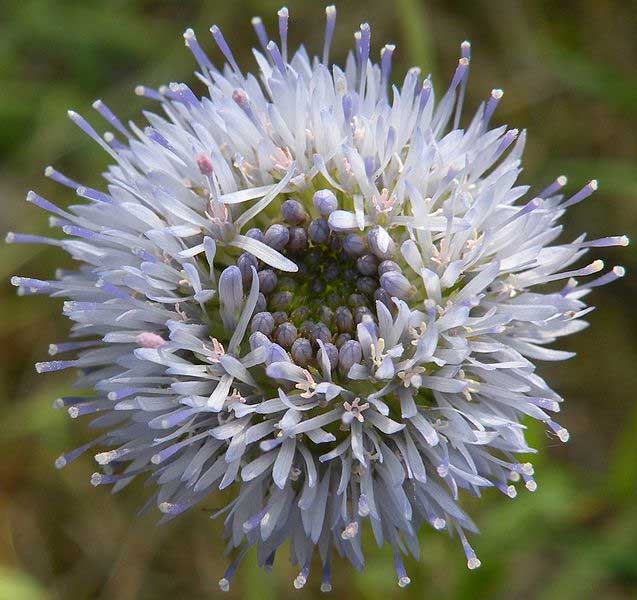
Jasione montana (*)
Classification System: APG IV
Superregnum: Eukaryota
Regnum: Plantae
Cladus: Angiosperms
Cladus: Eudicots
Cladus: Core eudicots
Cladus: Asterids
Cladus: Campanulids
Ordo: Asterales
Familia: Campanulaceae
Subfamilia: Campanuloideae
Genus: Jasione
Species: Jasione montana
Subspecies: J. m. subsp. cornuta – J. m. subsp. montana – J. m. subsp. paivae
Name
Jasione montana L., Sp. Pl.: 928 (1753).
Synonyms
Homotypic
Jasione vulgaris Gaterau, Descr. Pl. Montauban: 153 (1789), nom. superfl.
Phyteuma montanum (L.) C.K.Spreng., Entd. Geheimn. Nat.: 115 (1793).
Ovilla globulariiflora Rupr., Fl. Ingrica: 653 (1860), nom. superfl.
Distribution
Native distribution areas:
References
Linnaeus, C. 1753. Species Plantarum. Tomus II: 928. Reference page.
Links
Govaerts, R. et al. 2019. Jasione montana in World Checklist of Selected Plant Families. The Board of Trustees of the Royal Botanic Gardens, Kew. Published online. Accessed: 2019 Jul. 27. Reference page.
Hassler, M. 2019. Jasione montana. World Plants: Synonymic Checklists of the Vascular Plants of the World In: Roskovh, Y., Abucay, L., Orrell, T., Nicolson, D., Bailly, N., Kirk, P., Bourgoin, T., DeWalt, R.E., Decock, W., De Wever, A., Nieukerken, E. van, Zarucchi, J. & Penev, L., eds. 2019. Species 2000 & ITIS Catalogue of Life. Published online. Accessed: 2019 Jul. 27. Reference page.
International Plant Names Index. 2019. Jasione montana. Published online. Accessed: Jul 27 2019.
The Plant List 2013. Jasione montana in The Plant List Version 1.1. Published online. Accessed: 2019 Jul 27.
Tropicos.org 2019. Jasione montana. Missouri Botanical Garden. Published online. Accessed: 27 Jul 2019.
Vernacular names
čeština: Pavinec horský
Cymraeg: Clefryn
dansk: Almindelig Blåmunke
Deutsch: Berg-Sandglöckchen
English: Sheep's-bit
español: Botón azul
suomi: Vuorimunkki
français: Jasione des montagnes
Gaelg: Bossan gorrym
lietuvių: Kalninė austėja
norsk bokmål: Blåmunke
Nederlands: Zandblauwtje
polski: Jasieniec piaskowy
русский: Букашник горный
slovenčina: Pávinec horský
svenska: Blåmunkar
Türkçe: Kumçanı
українська: Агалик-трава гірська
Jasione montana is a low-growing plant in the family Campanulaceae found in rocky places and upland regions of Europe and western Asia. Common names include sheep's-bit, blue bonnets, blue buttons, blue daisy and iron flower. Due to the similarity of the common name of "sheep's-bit" with that of devil's-bit scabious (Succisa pratensis), it is sometimes called "sheep's-bit scabious" or "sheep scabious", but it is not related to the scabiouses (Dipsacoideae, Caprifoliaceae).
Distribution and habitat
Sininukk.JPG
This plant is found in the north temperate zone of Europe, west Asia and north Africa. It is a plant growing on heaths and moors in rocky or sandy districts, coastal cliffs, quarries and natural escarpments where the soil is thin.[1] It prefers acid soils and is absent from limestone regions. It is often found on coastal cliffs in association with thrift and kidney vetch and blooms from May to September.[2]
Description
Jasione montana
Sheep's bit scabious is a low biennial or occasionally annual plant growing up to about one foot tall with suberect stems that branch near the base. The leaves are linear, lanceolate, narrow at the base, sinuate, stiffly hairy and forming a rosette. The small violet-blue flowers are in small heads. The bracts are smooth or hairy and the petals have narrow lobes. There are 5 oblong anthers which unite at the base forming a tube, a feature that differentiates this plant from true scabiouses.[1]
The individual florets open successively. The anthers ripen first and later the styles elongate and the two-lobed stigmas are displayed. This make self-pollination less likely. There are nectaries in the upper part of the ovaries and many insects visit the flowers. Some fifty species of bees and wasps, thirty species of fly, thirty species of butterflies and moths and several beetles have been recorded as visiting the flowers,[1] and therefore this plant is characterized by a generalized pollination syndrome.[3]
The flowers are visible under ultraviolet light and it is believed that this makes them attractive to pollinating insects. They do not show a traditional bull's-eye pattern to guide the insect but the ultraviolet reflectance of the petals is very high.[4]
References
Harwood, A. R. British Wild Flowers In Their Natural Haunts Vol 5–6.
First Nature
Van Der Kooi, C. J.; Pen, I.; Staal, M.; Stavenga, D. G.; Elzenga, J. T. M. (2015). "Competition for pollinators and intra-communal spectral dissimilarity of flowers". Plant Biology. 18 (1): 56–62. doi:10.1111/plb.12328. PMID 25754608.
Ultraviolet flowers
Pink, A. (2004). Gardening for the Million. Project Gutenberg Literary Archive Foundation.
Retrieved from "http://en.wikipedia.org/"
All text is available under the terms of the GNU Free Documentation License

